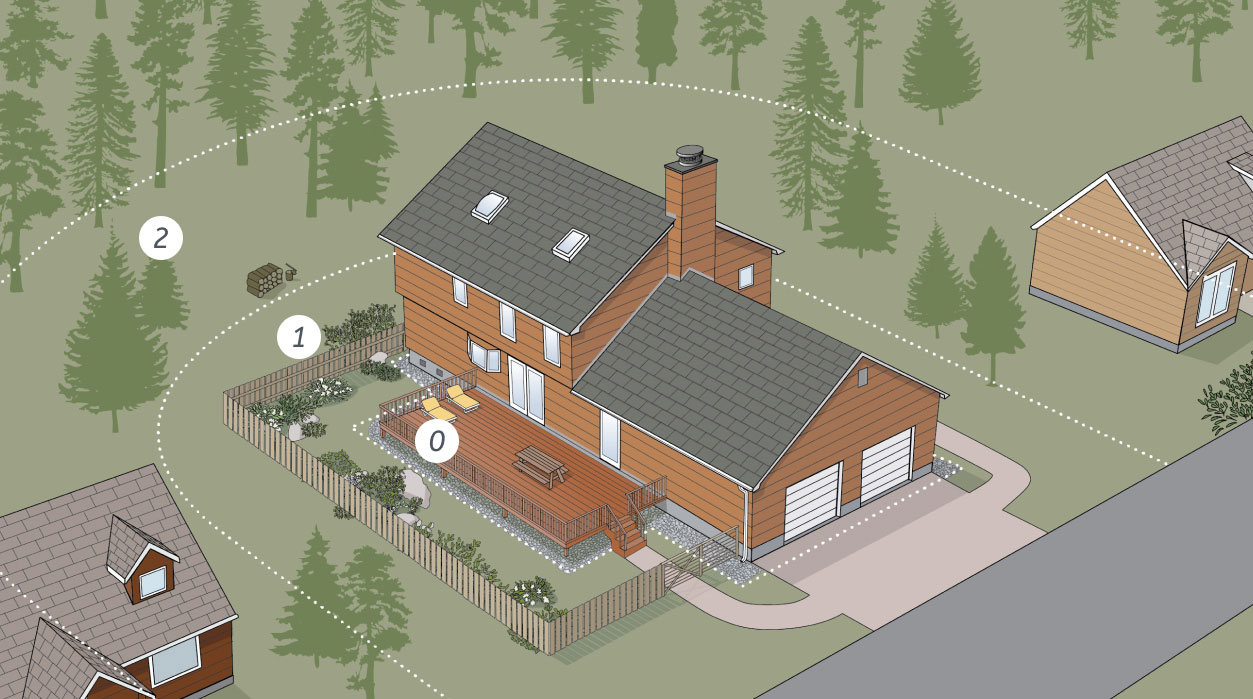How to Improve My Defensible Space
Defensible Space is the buffer around a home where the vegetation has been managed to reduce the wildfire hazard. By creating defensible space around your home, it increases the chance of home survival and provides a space for firefighters to safely defend the home during a wildfire event.

ZONE 0
The Ember-Resistant Zone
0–5 feet
The zone within 5 feet of your home has many different names (e.g., the noncombustible zone, the immediate zone, the zero zone), but the objective is generally the same—to reduce the vulnerability of the home to embers by creating a zone of ember-resistant materials around the home. Gravel, a concrete or brick walkway, or another hardscape feature is commonly used to construct this zone. This ember-resistant zone should include the area under and around any attached deck. Be sure to keep this zone clean of any woodpiles, wood mulch, or flammable vegetation.
ZONE 1
The Lean, Clean and Green Zone
5–30 feet
In this zone, remove dead vegetation and debris and maintain spacing between shrubs and trees. Remove “ladder fuels” (i.e. trees or shrubs that are growing under other trees) because they can increase the probability of fire moving into the tree canopy. If appropriate, irrigate vegetation in this zone.
ZONE 2
The Reduced Fuel Zone
30–100 feet +
The objective of this zone is to reduce fire spread and restrict fire movement into the crowns of trees or shrubs. Remove dead plant material, lower tree branches and other ladder fuels (e.g., shrubs, lower branches, smaller trees). Locate outbuildings (e.g., for storage) at least 30 feet away from the home and create an ember-resistant zone around all outbuildings and propane tanks.
Consider the Location & Setting
Think about the location and context of the home and how that influences vulnerability to wildfire:

Steep Slopes
When homes are located on steep slopes, decks commonly overhang the slope below, and this downslope area is often heavily vegetated. Prioritize defensible space actions so that flames from burning vegetation cannot reach the underside of the deck and ignite, with subsequent ignition of the home.

Dense Neighborhoods
Dense neighborhoods with homes close together have an increased risk of building-to-building ignition because of the radiated heat and potential flames that are generated if a neighbor’s home burns. Prioritize actions to reduce the possibility of homes igniting each other. Intensify defensible space by thinning trees and shrubs between homes. Engage in neighborhood conversations to encourage all neighbors to take actions to reduce their own vulnerability to wildfire.

Large Parcel
When homes are on large-parcel lots and neighboring homes are far apart, vegetation and other combustible materials on the property (e.g., wood pile, tool shed) can be a large factor in home ignition. Prioritize creating and maintaining defensible space, including the near-home noncombustible zone, and home-hardening techniques to reduce vulnerability from embers.
Publications
- Be Ember Aware! Will your home survive when the embers arrive?
- Fire Adapted Communities: The Next Step in Wildfire Preparedness (Nevada)
- Fire Adapted Communities: The Next Step in Wildfire Preparedness (Tahoe)
- Choosing the Right Plants for Northern Nevada’s High Fire Hazard Areas
- Choosing the Right Plants for Northern Nevada’s High Fire Hazard Areas – Lake Tahoe Basin
- The Combustibility of Landscape Mulches
- A Homeowner’s Guide to Cheatgrass
- Homeowner’s Guide to Planting Crested Wheatgrass
- Be Careful! Cheatgrass is extremely flammable!
- Firescaping – Landscape Design For Defensible Space
